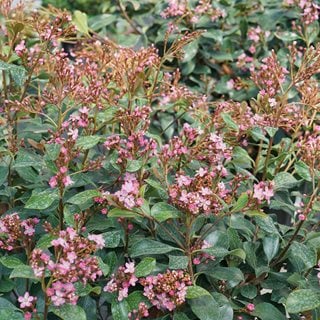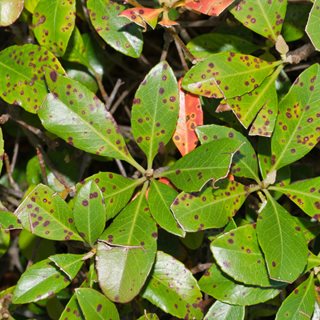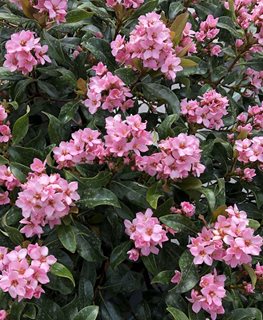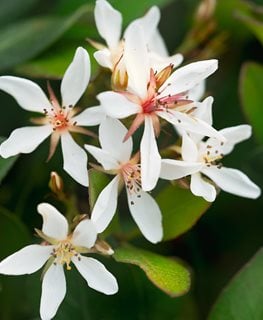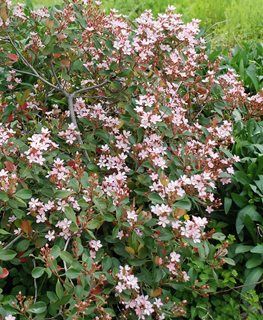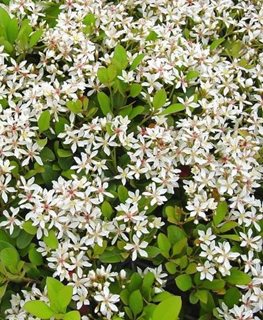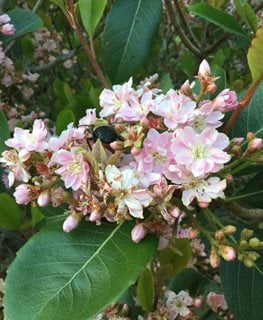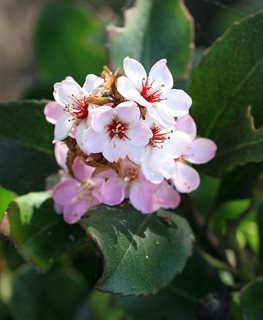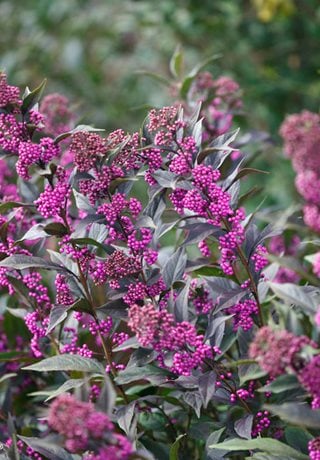How to Grow Indian Hawthorn
Add year-round interest to your landscape with this low-maintenance shrubIndian hawthorn is a broadleaf evergreen shrub suitable for warmer climates, with a wide array of uses in the landscape. Most varieties stay relatively small, making them a valuable addition to smaller spaces. This low-maintenance shrub is useful for foundation plantings, hedging, containers, and mass plantings.
Grown for its neat mounding habit, glossy leaves, profuse flower clusters, and attractive berries, this Asian native provides year-round interest as well as food and cover for wildlife. Tolerant of varying conditions, Indian hawthorn bush is suited to urban environments and coastal locations. Here’s how to plant and grow this versatile shrub.
On this page: Basics | Planting | Care and Maintenance | Pictures | Design Ideas | Freeze Protection
On this page:
- BASICS
- PLANTING INDIAN HAWTHORN
- INDIAN HAWTHORN CARE AND MAINTENANCE
- INDIAN HAWTHORN VARIETIES
- DESIGN IDEAS
- FREEZE PROTECTION
INDIAN HAWTHORN BASICS
Botanical name:
Rhaphiolepis indica, spp. and hybrids
Zones:
7-11
Habit:
Most varieties have a compact bushy habit.
Height/Spread:
From 1 to 6 feet tall and 3 to 6 feet wide. ‘Majestic Beauty’ is a larger hybrid that can grow 8 to 18 feet tall and 5 to 10 feet wide.
Light exposure:
Full sun to partial shade
Bloom time:
Late winter to spring; some varieties rebloom in summer and fall
Foliage:
Thick glossy green leaves 2 to 4 inches long are round or oval with serrated edges. New growth has bronze or maroon highlights, with leaves acquiring a purplish tinge during winter.
Flowers and fruit:
Fragrant pink or white crabapple-like five-petaled flowers appear in late winter to spring, followed by clusters of small rounded dark blue or purple berries that may persist into winter.
Is Indian hawthorn toxic?
Indian hawthorn is not considered toxic to humans or pets. The tart berries may be used to make jelly or jam.
Is Indian hawthorn deer resistant?
Deer find Indian hawthorn quite appealing, and can cause significant damage to plants.
HOW TO PLANT INDIAN HAWTHORN
When to plant:
Plant during the cooler months of spring or fall to avoid heat or cold stress.
Where to plant:
Choose a sunny site with well-draining soil and good air circulation. Plants do best with full sun, but can tolerate some shade. Too much shade can lead to poor flowering, leggy growth, and disease problems. Poor air circulation can contribute to fungal diseases.
How to plant:
Loosen soil in planting area and amend with compost or other organic matter. Dig a planting hole 2-3 times wider than the diameter of the root ball and slightly deeper. Tease out roots or make several slits in the root ball. Place the plant in the hole with the top of the root ball so it’s level or slightly above the surrounding ground to allow for settling. Cover the root ball with soil and tamp down to remove air pockets. Water thoroughly and keep soil evenly moist until established.
Spacing:
Allow enough space around plants to accommodate their mature size.
Planting Indian hawthorn in containers:
Make sure pots have adequate drainage holes. Use a high quality all-purpose potting soil.
INDIAN HAWTHORN CARE
Soil:
Indian hawthorn is adaptable to different soil types, but prefers well-amended soil with a pH between 6.0 and 7.5. Good drainage is essential to prevent root rot or other diseases.
Watering:
Keep soil evenly moist but not soggy. Avoid overhead watering, which can cause fungal diseases. Plants will become drought tolerant once established. Overwatering can cause root rot. Increase watering during heat or dry spells. Containers dry out more quickly and will need more frequent watering.
Amendments and fertilizer:
In optimal growing conditions, Indian hawthorn needs little supplemental fertilizer. In spring, apply a slow-release fertilizer formulated for trees and shrubs according to instructions.
Pruning:
Indian hawthorn needs little or no pruning. After flowering, trim back errant branches and shape as needed. Cut out dead or diseased growth as soon as it appears. Indian hawthorn can also be kept pruned as a formal hedge, though leaves that are sheared in half may look unsightly. Larger varieties such as ‘Majestic Beauty’ can be trained into a tree form.
Pests and diseases:
When grown in optimal conditions, Indian hawthorn will have few problems. However, it is very susceptible to leaf spot, especially in shade or with overhead watering or late spring rains. Other diseases include fire blight, phytophthora, powdery mildew, verticillium wilt, and root rot. Pests include aphids, nematodes, wax scale, and bagworms.
INDIAN HAWTHORN VARIETIES
Indian hawthorn alternatives:
Substitute Indian hawthorn with other similar looking shrubs such as aucuba, holly, boxwood or waxleaf privet.
USING INDIAN HAWTHORN IN THE LANDSCAPE
Here are some ideas on how to use this versatile shrub:
- Divide garden rooms with a smaller slow-growing form that can easily be kept pruned to the desired size.
- Combine Indian hawthorn with other shrubs that bloom at different times such as daphne, hydrangea, and bluebeard for sequential color throughout the growing season.
- Create a foundation planting along the front of your home with Indian hawthorn and other smaller shrubs with interesting foliage, flowers, and fruit for a captivating display.
- Place a large decorative container in a prominent sunny spot and plant an Indian hawthorn as a year-round accent.
- Use a low, spreading type as a groundcover along a slope or hillside for attractive low-maintenance erosion control.
- Edge a pathway with a dwarf variety for easy year-round color.
- Use a larger variety as privacy screening or train into a small tree.
Companion plants:Companion plants for Indian hawthorn include aucuba, juniper, Yaupon holly, strawberry bush, crape myrtle, and cotoneaster.
DOES INDIAN HAWTHORN FREEZE?
If winter temperatures dip below 20 degrees F, Indian hawthorn shrubs can suffer from cold damage. Leaves become wilted before turning brown or black. Bark may split or crack along the trunk. In extreme cases, plants will die. Healthy plants will be more resilient.
To help prevent freeze damage, follow these steps:
- Make sure plants are in a site that receives full sun.
- Microclimates offer additional protection, such as sites against buildings, near pavement that radiates heat, areas with southern exposure, and shelter from desiccating winds.
- Stop fertilizing plants in fall to avoid stimulating new growth, which is more prone to cold injury.
- If soil is dry, water plants well to prevent drought stress.
- Apply several inches of mulch around the base to insulate roots.
- During cold spells, cover plants with cloth or burlap.
- In marginal climates, plant cultivars that are more cold tolerant.
If plants suffer cold damage, wait until spring before taking any further action. When the weather warms, look for new leaf growth and inspect trunks to see if there’s live green wood underneath the bark. If the plant is still alive, remove any affected foliage, as well as dead or damaged branches. Resume normal watering and fertilizing. Remove dead plants.
RELATED:
Shrubs 101
Top 15 Evergreen Shrubs for Your Garden
16 Best Flowering Shrubs
